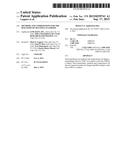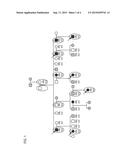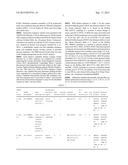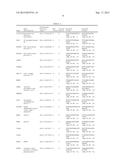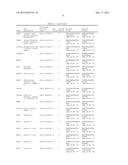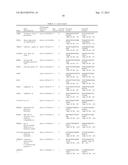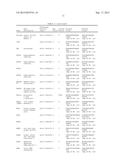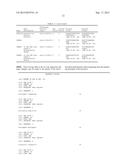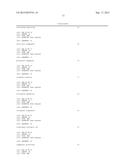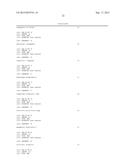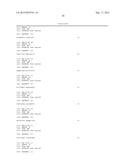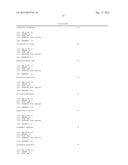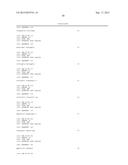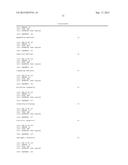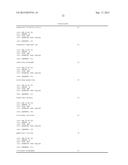Patent application title: METHODS AND COMPOSITIONS FOR THE DIAGNOSIS OF MULTIPLE SCLEROSIS
Inventors:
Mark F. Leppert (Salt Lake City, UT, US)
John W. Rose (Salt Lake City, UT, US)
Nori Matsunami (Salt Lake City, UT, US)
Charles Henry Hensel (Salt Lake City, UT, US)
IPC8 Class: AC12Q168FI
USPC Class:
Class name:
Publication date: 2015-09-17
Patent application number: 20150259741
Abstract:
Disclosed herein are methods and compositions for diagnosing multiple
sclerosis ("MS") in a subject or the risk of MS in a subject. More
particularly, methods and compositions for the use of genetic markers for
diagnosing MS in subject or the risk of MS in a subject.Claims:
1. A method of determining the risk of multiple sclerosis (MS), the
method comprising: assaying a biological sample of a subject for the
presence of at least one variant allele listed in Table 1 and Table 2;
wherein the presence of the at least one variant allele is indicative of
a risk of MS.
2. The method of claim 1, wherein the sample is assayed for the presence of at least one variant allele listed in Table 1 and Table 2 with at least one assay selected from a PCR assay, SNP array, PCR-based SNP genotyping, DNA hybridization, fluorescence microscopy, and immunoassay.
3. The method of claim 1, wherein the sample is assayed for the presence of at least one variant allele listed in Table 1 and Table 2 with a PCR assay using one or more of the PCR primer sequences selected from SEQ ID NOS: 1-156.
4. The method of claim 1, wherein the sample is assayed for the presence of at least one variant allele listed in Table 1 with a PCR assay using one or more of the PCR primer sequences selected from SEQ ID NOS: 1-6.
5. The method of claim 1, wherein the sample is assayed for the presence of at least one variant allele listed in Table 1 by assaying the sample for the presence of at least one of the chromosome 16 variant allele of Table 1, in the gene ELMO3, at position chr16:67236368, using the forward primer ACTCCAGGCTCTGAGACAGC (SEQ ID NO: 1) and the reverse primer CACCTTGTCGAAGTCCTCCT (SEQ ID NO: 2), wherein the variant allele is A; the chromosome 16 variant allele of Table 1, in the gene ZFHX3 (ATBF1), at position chr16:72993489, using the forward primer TATTCGGGAAAGCCTGGTCT (SEQ ID NO: 3) and the reverse primer CCTCGCTTTTCCTGAACTCT (SEQ ID NO: 4), wherein the variant allele is C; and the chromosome 16 variant allele of Table 1, in the gene IL34, at position chr16:70690511, using the forward primer GGAGCCTGCTGGTCATTTCT (SEQ ID NO: 5) and the reverse primer CAGGAAGGGATTCTCACCAG (SEQ ID NO: 6), wherein the variant allele is C.
6. The method of claim 5, wherein the sample is assayed for the presence of both the chromosome 16 variant allele of Table 1, in the gene ELMO3, at position chr16:67236368, using the forward primer ACTCCAGGCTCTGAGACAGC (SEQ ID NO: 1) and the reverse primer CACCTTGTCGAAGTCCTCCT (SEQ ID NO: 2), wherein the variant allele is A; and the chromosome 16 variant allele of Table 1, in the gene ZFHX3 (ATBF1), at position chr16:72993489, using the forward primer TATTCGGGAAAGCCTGGTCT (SEQ ID NO: 3) and the reverse primer CCTCGCTTTTCCTGAACTCT (SEQ ID NO: 4), wherein the variant allele is C.
7. The method of claim 5, wherein the sample is assayed for the presence of both the chromosome 16 variant allele of Table 1, in the gene ELMO3, at position chr16:67236368, using the forward primer ACTCCAGGCTCTGAGACAGC (SEQ ID NO: 1) and the reverse primer CACCTTGTCGAAGTCCTCCT (SEQ ID NO: 2), wherein the variant allele is A; and the chromosome 16 variant allele of Table 1, in the gene IL34, at position chr16:70690511, using the forward primer GGAGCCTGCTGGTCATTTCT (SEQ ID NO: 5) and the reverse primer CAGGAAGGGATTCTCACCAG (SEQ ID NO: 6), wherein the variant allele is C.
8. The method of claim 5, wherein the sample is assayed for the presence of both the chromosome 16 variant allele of Table 1, in the gene ZFHX3 (ATBF1), at position chr16:72993489, using the forward primer TATTCGGGAAAGCCTGGTCT (SEQ ID NO: 3) and the reverse primer CCTCGCTTTTCCTGAACTCT (SEQ ID NO: 4), wherein the variant allele is C; and the chromosome 16 variant allele of Table 1, in the gene IL34, at position chr16:70690511, using the forward primer GGAGCCTGCTGGTCATTTCT (SEQ ID NO: 5) and the reverse primer CAGGAAGGGATTCTCACCAG (SEQ ID NO: 6), wherein the variant allele is C.
9. The method of claim 1, wherein the sample is assayed for the presence of at least one variant allele listed in Table 2 with a PCR assay using one or more of the forward and reverse primers sequences selected from SEQ ID NOS: 7-156.
10. The method of claim 1, wherein the presence of the at least one variant allele indicates a diagnosis of MS in the subject.
11. An in vitro diagnostic product for detecting the risk of MS in a subject, the product comprising: at least one laboratory test for assaying a biological sample of a subject for the presence of at least one variant allele listed in Table 1 and Table 2 wherein the presence of the at least one variant allele is indicative of a risk of MS.
12. The in vitro diagnostic product of claim 11, wherein the sample is assayed for the presence of at least one variant allele listed in Table 1 and Table 2 with at least one assay selected from a PCR assay, SNP array, PCR-based SNP genotyping, DNA hybridization, fluorescence microscopy, and immunoassay.
13. The in vitro diagnostic product of claim 11, wherein the sample is assayed for the presence of at least one variant allele listed in Table 1 and Table 2 with a PCR assay using one or more of the PCR primer sequences selected from SEQ ID NOS: 1-156.
14. The in vitro diagnostic product of claim 11, wherein the sample is assayed for the presence of at least one variant allele listed in Table 1 with a PCR assay using one or more of the PCR primer sequences selected from SEQ ID NOS: 1-6.
15. The in vitro diagnostic product of claim 11, wherein the sample is assayed for the presence of at least one variant allele listed in Table 1 by assaying the sample for the presence of at least one of the chromosome 16 variant allele of Table 1, in the gene ELMO3, at position chr16:67236368, using the forward primer ACTCCAGGCTCTGAGACAGC (SEQ ID NO: 1) and the reverse primer CACCTTGTCGAAGTCCTCCT (SEQ ID NO: 2), wherein the variant allele is A; the chromosome 16 variant allele of Table 1, in the gene ZFHX3 (ATBF1), at position chr16:72993489, using the forward primer TATTCGGGAAAGCCTGGTCT (SEQ ID NO: 3) and the reverse primer CCTCGCTTTTCCTGAACTCT (SEQ ID NO: 4), wherein the variant allele is C; and the chromosome 16 variant allele of Table 1, in the gene IL34, at position chr16:70690511, using the forward primer GGAGCCTGCTGGTCATTTCT (SEQ ID NO: 5) and the reverse primer CAGGAAGGGATTCTCACCAG (SEQ ID NO: 6), wherein the variant allele is C.
16. The in vitro diagnostic product of claim 15, wherein the sample is assayed for the presence of both the chromosome 16 variant allele of Table 1, in the gene ELMO3, at position chr16:67236368, using the forward primer ACTCCAGGCTCTGAGACAGC (SEQ ID NO: 1) and the reverse primer CACCTTGTCGAAGTCCTCCT (SEQ ID NO: 2), wherein the variant allele is A; and the chromosome 16 variant allele of Table 1, in the gene ZFHX3 (ATBF1), at position chr16:72993489, using the forward primer TATTCGGGAAAGCCTGGTCT (SEQ ID NO: 3) and the reverse primer CCTCGCTTTTCCTGAACTCT (SEQ ID NO: 4), wherein the variant allele is C.
17. The in vitro diagnostic product of claim 15, wherein the sample is assayed for the presence of both the chromosome 16 variant allele of Table 1, in the gene ELMO3, at position chr16:67236368, using the forward primer ACTCCAGGCTCTGAGACAGC (SEQ ID NO: 1) and the reverse primer CACCTTGTCGAAGTCCTCCT (SEQ ID NO: 2), wherein the variant allele is A; and the chromosome 16 variant allele of Table 1, in the gene IL34, at position chr16:70690511, using the forward primer GGAGCCTGCTGGTCATTTCT (SEQ ID NO: 5) and the reverse primer CAGGAAGGGATTCTCACCAG (SEQ ID NO: 6), wherein the variant allele is C.
18. The in vitro diagnostic product of claim 15, wherein the sample is assayed for the presence of both the chromosome 16 variant allele of Table 1, in the gene ZFHX3 (ATBF1), at position chr16:72993489, using the forward primer TATTCGGGAAAGCCTGGTCT (SEQ ID NO: 3) and the reverse primer CCTCGCTTTTCCTGAACTCT (SEQ ID NO: 4), wherein the variant allele is C; and the chromosome 16 variant allele of Table 1, in the gene IL34, at position chr16:70690511, using the forward primer GGAGCCTGCTGGTCATTTCT (SEQ ID NO: 5) and the reverse primer CAGGAAGGGATTCTCACCAG (SEQ ID NO: 6), wherein the variant allele is C.
19. The in vitro diagnostic product of claim 15, wherein the sample is assayed for the presence of at least one variant allele listed in Table 2 with a PCR assay using one or more of the forward and reverse primers sequences selected from SEQ ID NOS: 7-156.
20. The in vitro diagnostic product of claim 11, wherein the presence of the at least one variant allele indicates a diagnosis of MS in the subject.
Description:
RELATED APPLICATIONS
[0001] This application claims priority to U.S. Provisional Application No. 61/723,077, entitled "Haplotype Sharing and Linkage Analyses of Multigenerational Families with Multiple Sclerosis" and filed on Nov. 6, 2012, which is incorporated herein by reference in its entirety.
TECHNICAL FIELD
[0002] The present disclosure relates to methods and compositions for determining the risk of multiple sclerosis (MS) or the diagnosis of MS. The present disclosure also relates to the use of genetic markers for determining risk of MS and the diagnosis of MS.
BACKGROUND
[0003] MS is an autoimmune disease that affects the central nervous system (CNS). The CNS consists of the brain, spinal cord, and the optic nerves. Surrounding and protecting the nerve fibers of the CNS is a fatty tissue called myelin which helps nerve fibers conduct electrical impulses. In MS, myelin is lost in multiple areas, leaving scar tissue called sclerosis. These damaged areas are also known as plaques or lesions. Sometimes the nerve fiber itself is damaged or broken. When myelin or the nerve fiber is destroyed or damaged, the ability of the nerves to conduct electrical impulses to and from the brain is disrupted, and this produces the various symptoms of MS.
[0004] MS is a complex disease with heterogeneous disease course, neuropathology and gender bias. The disorder features autoimmunity, inflammation, neurodegeneration and impaired regeneration. Distinct neuropathologies are now being associated with the progressive and relapsing states of the disease. In terms of etiology, family studies have shown that MS has a genetic component. Additionally, there are likely a number of environmental factors, such as exposure to certain pathogens or damage mechanisms, which might increase MS susceptibility.
[0005] People with MS can expect one of four clinical courses of disease, each of which might be mild, moderate, or severe. These include Relapsing-Remitting (RR), Primary-Progressive (PP), Secondary-Progressive (SP), and Progressive-Relapsing (PR). Individuals with RR MS experience clearly defined flare-ups (also called relapses, attacks, or exacerbations). These are episodes of acute worsening of neurologic function. They are followed by partial or complete recovery periods (remissions) free of disease progression. Individuals with PP MS experience a slow but nearly continuous worsening of their disease from the onset, with no distinct relapses or remissions. However, there are variations in rates of progression over time, occasional plateaus, and temporary minor improvements. Individuals with SP MS experience an initial period of relapsing-remitting disease, followed by a steadily worsening disease course with or without occasional flare-ups, minor recoveries (remissions), or plateaus. Individuals with PR MS experience a steadily worsening disease from the onset but also have clear acute relapses (attacks or exacerbations), with or without recovery. In contrast to RR MS, the periods between relapses are characterized by continuing disease progression.
[0006] Patients can progress rapidly over several months to death, or may have a few relapses and then remain clinically stable for many decades. It is difficult to predict which patients will progress and which will remain relatively stable. Although there are clearly patients in whom the disease remains benign, it is very difficult to predict which course a patient's disease will follow.
[0007] At this time, there is no cure for MS. Despite treatment with available agents, a majority of patients eventually progress to a SP stage of disease leading to severe disability. The ability to identify individuals who have a risk of MS and to reliably diagnose MS would be very valuable to increase the likelihood of successful treatment.
BRIEF DESCRIPTION OF THE DRAWINGS
[0008] FIG. 1 shows a multigenerational MS pedigree. Affy 6.0 indicates samples genotyped with an Affymetrix Genome-Wide Human SNP array 6.0. The circled samples were used for phased haplotype sharing analysis. The arrows point to samples used for custom targeted enrichment and next-gen DNA sequencing.
[0009] FIGS. 2A and 2B show the results of a phased haplotype sharing analysis.
[0010] FIG. 3 shows the overlap of the Utah K1601 chromosome 12 MS region 12p12.3-q12 with a MS region described in another multiplex MS family.
DETAILED DESCRIPTION
[0011] Disclosed are molecules, materials, compositions, and components that can be used for, can be used in conjunction with, can be used in preparation for, or are products of the disclosed methods and compositions. These and other materials are disclosed herein, and it is understood that when combinations, subsets, interactions, groups, etc., of these materials are disclosed that while specific reference of each various individual and collective combinations and permutation of these molecules and compounds may not be explicitly disclosed, each is specifically contemplated and described herein. For example, if a nucleotide or nucleic acid is disclosed and discussed and a number of modifications that can be made to a number of molecules including the nucleotide or nucleic acid are discussed, each and every combination and permutation of nucleotide or nucleic acid and the modifications that are possible are specifically contemplated unless specifically indicated to the contrary. This concept applies to all aspects of this application including, but not limited to, steps in methods of making and using the disclosed molecules and compositions. Thus, if there are a variety of additional steps that can be performed it is understood that each of these additional steps can be performed with any specific embodiment or combination of embodiments of the disclosed methods, and that each such combination is specifically contemplated and should be considered disclosed.
[0012] Those skilled in the art will recognize, or be able to ascertain using no more than routine experimentation, many equivalents to the specific embodiments of the method and compositions described herein. Such equivalents are intended to be encompassed by the following claims.
[0013] It is understood that the disclosed methods and compositions are not limited to the particular methodology, protocols, and reagents described as these may vary. It is also to be understood that the terminology used herein is for the purpose of describing particular embodiments only, and is not intended to limit the scope of the present invention which will be limited only by the appended claims.
[0014] Unless defined otherwise, all technical and scientific terms used herein have the meanings that would be commonly understood by one of skill in the art in the context of the present specification.
[0015] It must be noted that as used herein and in the appended claims, the singular forms "a," "an," and "the" include plural reference unless the context clearly dictates otherwise. Thus, for example, reference to "a nucleotide" includes a plurality of such nucleotides; reference to "the nucleotide" is a reference to one or more nucleotides and equivalents thereof known to those skilled in the art, and so forth.
[0016] As used herein, the term "subject" means any target of administration. The subject can be a vertebrate, for example, a mammal. Thus, the subject can be a human. The term does not denote a particular age or sex. Thus, adult and newborn subjects, as well as fetuses, whether male or female, are intended to be covered. A patient refers to a subject afflicted with a disease or disorder. Unless otherwise specified, the term "patient" includes human and veterinary subjects.
[0017] As used herein, the term "biomarker" or "biological marker" means an indicator of a biologic state and may include a characteristic that is objectively measured as an indicator of normal biological processes, pathologic processes, or pharmacologic responses to a therapeutic or other intervention. In one embodiment, a biomarker may indicate a change in expression or state of a protein that correlates with the risk or progression of a disease, or with the susceptibility of the disease in an individual. In certain embodiments, a biomarker may include one or more of the following: genes, proteins, glycoproteins, metabolites, cytokines, and antibodies.
[0018] As used herein, the term "in vitro diagnostic" means diagnostic tests that may be used to detect or indicate the presence of, the predisposition to, or the risk of, diseases, conditions, infections and/or therapeutic responses. In one embodiment, an in vitro diagnostic may be used in a laboratory or other health professional setting. In another embodiment, an in vitro diagnostic may be used by a consumer at home. In vitro diagnostic products are those reagents, instruments, and systems intended for use in the in vitro diagnosis of disease or other conditions, including a determination of the state of health, in order to cure, mitigate, treat, or prevent disease or its sequelae. In one embodiment, in vitro diagnostic products may be intended for use in the collection, preparation, and examination of specimens taken from the human body. In certain embodiments, in vitro diagnostic products may comprise one or more laboratory tests such as one or more in vitro diagnostic tests. As used herein, the term "laboratory test" means one or more medical or laboratory procedures that involve testing samples of blood, urine, or other tissues or substances in the body.
[0019] In one embodiment, the methods and in vitro diagnostic products described herein may be used for the diagnosis of MS in at-risk patients, patients with non-specific symptoms possibly associated with MS, and/or patients presenting with Clinically Isolated Syndrome. In another embodiment, the methods and in vitro diagnostic products described herein may be used for screening for risk of progressing from at-risk, non-specific symptoms possibly associated with MS, and/or Clinically Isolated Syndrome to fully-diagnosed MS. In certain embodiments, the methods and in vitro diagnostic products described herein can be used to rule out screening of diseases and disorders that share symptoms with MS. In yet another embodiment, the methods and in vitro diagnostic products described herein may indicate diagnostic information to be included in the current diagnostic evaluation in patients suspected of having MS.
[0020] A drug or pharmaceutical agent means any substance used in the prevention, diagnosis, alleviation, treatment or cure of a disease. These terms include a vaccine, for example.
[0021] The present disclosure also includes nucleic acid molecules that are oligonucleotides capable of hybridizing, under stringent hybridization conditions, with complementary regions of a gene or chromosome region containing a polymorphism or variant allele of the present disclosure. A nucleic acid can be DNA or RNA, and single- or double-stranded. Oligonucleotides can be naturally occurring or synthetic, but are typically prepared by synthetic means. Preferred oligonucleotides of the invention include segments of DNA, or their complements. The segments are usually between 5 and 200 contiguous bases, and often range from 5, 10, 12, 15, 20, or 25 nucleotides to 10, 15, 30, 25, 20, 50, 100, 150 or 200 nucleotides. Nucleic acids between 5-10, 5-20, 10-20, 12-30, 15-30, 10-50, 20-50, 20-100, or 20-200 bases are common. The variant allele or polymorphic site can occur within any position of the segment of DNA, gene, or chromosome region.
[0022] Oligonucleotides of the present disclosure can be RNA, DNA, or derivatives of either. The minimum size of such oligonucleotides is the size required for formation of a stable hybrid between an oligonucleotide and a complementary sequence on a nucleic acid molecule of the present disclosure. The present disclosure includes oligonucleotides that can be used as, for example, probes to identify nucleic acid molecules or primers to produce nucleic acid molecules. Oligonucleotide probes or primers may include a single base change of a variant or polymorphism of the present disclosure or the wildtype nucleotide that is located at the same position. In certain embodiments, the nucleotide of interest may occupy a central position of a probe. In one embodiment, the nucleotide of interest occupies a 3' position of a primer.
[0023] In another embodiment of the present disclosure, an array of oligonucleotides are provided, where discrete positions on the array are complementary to one or more of the variants disclosed herein. Such an array may comprise a series of oligonucleotides, each of which can specifically hybridize to particular nucleotide variant or polymorphism. Arrays of interest may further comprise sequences, including polymorphisms, of other genetic sequences, particularly other sequences of interest for pharmacogenetic screening. As with other human polymorphisms, the polymorphisms and variants of the disclosure also have more general applications, such as forensic, paternity testing, linkage analysis and positional cloning.
[0024] Described herein are methods directed to identifying subjects predisposed to MS or with a risk of developing MS. Also described herein are methods for diagnosing MS in a subject. In one embodiment, the methods disclosed may be used to characterize the clinical course or status of MS in a subject. In one embodiment, the methods as disclosed herein may be used to predict a response in a subject to an existing treatment for MS, or a treatment for MS that is in development or has yet to be developed. In one embodiment, the methods may be used to determine whether a patient may be more or less responsive to immunotherapies. In another embodiment, the methods described herein may be used to predict a response to a treatment with one or more immunological agents. In another embodiment, the methods may be used to predict a response to a treatment with Copaxone®. In another embodiment, the methods described herein may be used to predict the response to a therapy with Tysabri®.
[0025] In one embodiment, the presence or absence of certain genetic markers, such as one or more variant alleles, may be used to identify individuals that may have MS, are predisposed to MS, or have a risk or susceptibility to developing MS. As used herein, the term "susceptibility" or "susceptible" means that an individual has MS or is predisposed or at risk of developing MS.
[0026] In yet another embodiment, the variant alleles disclosed herein may be used for the stratification of MS patients according to their disease status, progression or the predicted response to one or more MS therapies. In another embodiment, one or more clinical, neuroradiological, genetic and/or immunological markers may be used to predict the response of a subject to one or more treatments or therapies for MS. In one such embodiment, the presence or absence of certain genetic markers, such as variant alleles, may be used to predict the response to one or more MS therapies. In another embodiment, the presence or absence of certain phenotypic variables, along with certain variant alleles, may be used to diagnose MS in a subject. In yet another embodiment, the presence or absence of phenotypic markers and/or variant alleles may be used to determine the clinical status of a MS patient and whether a patient is more likely to have a favorable clinical outcome with a certain MS therapy.
[0027] In one embodiment, the presence or absence of one or more variant alleles may be used to indicate the clinical disease status of a subject. In one such embodiment, the presence or absence of one or more variant alleles may indicate whether a subject may be stratified or characterized as having one of four clinical courses of disease consisting of Relapsing-Remitting (RR), Primary-Progressive (PP), Secondary-Progressive (SP), and Progressive-Relapsing (PR).
[0028] The teachings disclosed herein provide a collection of functionally relevant MS variant alleles and polymorphisms in genes or chromosomal regions. Detection of polymorphisms is useful in designing and performing diagnostic assays for evaluation of genetic risks or susceptibility for MS and other related conditions. Analysis of polymorphisms is also useful in designing prophylactic and therapeutic regimes customized to MS treatments. Detection of polymorphisms is also useful for conducting clinical trials of drugs for treatment of MS.
[0029] Polymorphism refers to the occurrence of two or more genetically determined alternative nucleotide sequences or alleles in a population. A polymorphic genetic marker or site is the locus at which divergence occurs. In one embodiment, genetic markers have at least two alleles, each occurring at a frequency of greater than 1%, and more preferably greater than 10% or 20% of a selected population. A polymorphic locus may be as small as one base pair.
[0030] Polymorphic genetic markers may include single nucleotide polymorphisms (SNP), single nucleotide variants (SNV), restriction fragment length polymorphisms (RFLP), exonic variants, splicing variants, variant alleles, variable number of tandem repeats (VNTRs), hypervariable regions, minisatellites, dinucleotide repeats, trinucleotide repeats, tetranucleotide repeats, simple sequence repeats, and insertion elements.
[0031] A single nucleotide polymorphism (SNP) occurs at a polymorphic site occupied by a single nucleotide, which is the site of variation between allelic sequences. A SNP may arise due to substitution of one nucleotide for another at the polymorphic site. A transition is the replacement of one purine by another purine or one pyrimidine by another pyrimidine. A transversion is the replacement of a purine by a pyrimidine or vice versa. SNPs can also arise from a deletion of a nucleotide or an insertion of a nucleotide relative to a reference allele.
[0032] As used herein, the nucleotide sequences disclosed herein encompass the complements of said nucleotide sequences. In addition, as used herein, the term "SNP" encompasses any allele among a set of alleles. The term "allele" refers to a specific nucleotide among a selection of nucleotides defining a SNP. In certain embodiments, the alleles at the site of an SNP may be a reference allele or a variant allele.
[0033] In one embodiment, the presence or absence of one or more variant alleles, genetic markers, polymorphisms, or genetic variants may be predictive of whether an individual is at risk or susceptibly to MS. In one such embodiment, one or more genetic markers may be identified as being associated with a disease phenotype by the use of a genome wide association study (GWAS). As generally know by those of skill in the art, a GWAS is an examination of genetic polymorphism across a genome, designed to identify genetic associations with a trait or phenotype of interest, such as MS. If genetic polymorphisms are more frequent in people with MS, the variations are said to be "associated" with MS. The polymorphisms associated with MS may either directly cause the disease phenotype or they may be in linkage disequilibrium with nearby genetic mutations that influence the individual variation in the disease phenotype. Linkage disequilibrium, as used herein, is the non-random association of alleles at two or more loci. In certain embodiments, a GWAS may be accompanied by a phased haplotype sharing analysis.
[0034] In one embodiment, a GWAS may be conducted using a DNA microarray as generally known in the art. Array-based detection can be performed to detect genetic polymorphisms. Commercially available arrays, e.g. Affymetrix Genome-Wide Human SNP array 6.0, from Affymetrix, Inc. (Santa Clara, Calif.) or other manufacturers may be used to detect polymorphisms. Reviews regarding the operation of nucleic acid arrays include Sapolsky et al. (1999) "High-throughput polymorphism screening and genotyping with high-density oligonucleotide arrays." Genetic Analysis: Biomolecular Engineering 14:187-192; Lockhart (1998) "Mutant yeast on drugs" Nature Medicine 4:1235-1236; Fodor (1997) "Genes, Chips and the Human Genome." FASEB Journal 11:A879; Fodor (1997) "Massively Parallel Genomics." Science 277: 393-395; and Ghee et al. (1996) "Accessing Genetic Information with High-Density DNA Arrays." Science 274:610-614, each of which is incorporated herein by reference.
[0035] As generally known in the art, a variety of probe arrays can be used for detection of polymorphisms that can be correlated to the phenotypes of interest. In one embodiment, DNA probe array chips or larger DNA probe array wafers (from which individual chips would otherwise be obtained by breaking up the wafer) may be used. In one such embodiment, DNA probe array wafers may comprise glass wafers on which high density arrays of DNA probes (short segments of DNA) have been placed. Each of these wafers can hold, for example, millions of DNA probes that are used to recognize sample DNA sequences (e.g., from individuals or populations that may comprise polymorphisms of interest). In certain embodiments, the DNA samples may be from individuals from multigenerational families with members that are affected and unaffected with MS. The recognition of sample DNA by the set of DNA probes on the glass wafer takes place through DNA hybridization. When a DNA sample hybridizes with an array of DNA probes, the sample binds to those probes that are complementary to the sample DNA sequence. By evaluating to which probes the sample DNA for an individual hybridizes more strongly, it is possible to determine whether a known sequence of nucleic acid is present or not in the sample, thereby determining whether a polymorphism found in the nucleic acid is present.
[0036] In one embodiment, the use of DNA probe arrays to obtain allele information typically involves the following general steps: design and manufacture of DNA probe arrays, preparation of the sample, hybridization of sample DNA to the array, detection of hybridization events and data analysis to determine the presence or absence of variant alleles. In one such embodiment, wafers may be manufactured using a process adapted from semiconductor manufacturing to achieve cost effectiveness and high quality, and are available, e.g., from Affymetrix, Inc. of Santa Clara, Calif.
[0037] In one embodiment, genetic markers used to diagnose MS, a predisposition or increased risk or susceptibility to MS, or a response to a MS therapeutic, may include one or more SNPs. As disclosed herein, a SNP may be identified by its name or by location within a particular sequence. The nucleotides flanking an SNP are the flanking sequences which may be used to identify the location of the SNP in the genome. In other embodiments, genetic markers used to diagnose MS, a predisposition or increased risk or susceptibility to MS, or a response to a MS therapeutic, may include one or more variant alleles.
[0038] In one embodiment, the variant alleles used to diagnose a predisposition or increased risk of MS, diagnose MS, or a response to a MS therapeutic, may include one or more loci located in a particular region of a chromosome. In one embodiment, the variant alleles may be located in a region of a chromosome selected from one or more of the chromosomal regions comprising 12p12.3-q12 and 16q21-q22.3. In another embodiment, the polymorphisms and variants used to diagnose MS, or a predisposition or increased risk of MS, may be one or more variants of one or more of the genes comprising C1orf125, PLD5, NCKAP5, NCKAP5, SCN9A, TUBA4A, ZNF717, NPHP3, LEKR1, EHHADH, AIF1, HIVEP2, RELN, IL2RA, CD6, RAB38, PTPRO, STRAP, PIK3C2G, PLEKHA5, PDE3A, GYS2, ERGIC2, ABCD2, COL2A1, OR10AD1, FMNL3, SLC11A2, KRT80, KRT75, KRT74, KRT76, KRT3, ITGB7, UTP20, TUBA3C, SLITRK6, NUBPL, SNX29, CNOT1, GOT2, CDH11, CDH16, C16orf70, ELMO3, FAM65A, RLTPR, PARD6A, C16orf48, TSNAXIP1, TSNAXIP1, SLC12A4, COG8, FUK, IL34, HYDIN, MARVELD3, PHLPP2, PKD1L3, ZFHX3, MLKL, FA2H, WDR59, ZNRF1, BCAR1, ADAT1, KARS, KIAA1012, and CPAMD8. In particular embodiments, the polymorphisms and variants used to diagnose MS, or a predisposition or increased risk of MS, may be one or more variant alleles described in Table 1 and Table 2.
[0039] The variant alleles as provided herein may include one or more variant alleles described in Table 1 and Table 2. The presence of variant alleles in a genetic sample may be determined by using one or more synthetic PCR primer sequences selected from the sequences identified by SEQ ID NOS: 1-156. In particular embodiments, the variant alleles of Table 1 may be identified using the forward and reverse primers sequences selected from SEQ ID NOS: 1-6. In one embodiment, the presence of the chromosome 16 variant allele of Table 1, in the gene ELMO3, at position chr16:67236368, may be assayed using the forward primer ACTCCAGGCTCTGAGACAGC (SEQ ID NO: 1) and the reverse primer CACCTTGTCGAAGTCCTCCT (SEQ ID NO: 2), wherein the variant allele is "A". In another embodiment, the presence of the chromosome 16 variant allele of Table 1, in the gene ZFHX3 (ATBF1), at position chr16:72993489, may be assayed using the forward primer TATTCGGGAAAGCCTGGTCT (SEQ ID NO: 3) and the reverse primer CCTCGCTTTTCCTGAACTCT (SEQ ID NO: 4), wherein the variant allele is "C". In a further embodiment, the presence of the chromosome 16 variant allele of Table 1, in the gene IL34, at position chr16:70690511, may be assayed using the forward primer GGAGCCTGCTGGTCATTTCT (SEQ ID NO: 5) and the reverse primer CAGGAAGGGATTCTCACCAG (SEQ ID NO: 6), wherein the variant allele is "C".
[0040] In one embodiment, the methods disclosed herein may comprise assaying for the presence of one or more variant alleles or polymorphisms in an individual which may include methods generally known in the art. In one such embodiment, methods for assaying for the presence of one or more variant alleles in an individual may include assaying an individual for the presence or absence of one or more variant alleles using one or more genotyping assays such as a PCR assay, SNP array, PCR-based SNP genotyping, DNA hybridization, fluorescence microscopy, immunoassay, and other methods known by those of skill in the art. In another embodiment, methods for assaying the presence or absence of one or more SNP markers may include providing a nucleotide sample from an individual and assaying the nucleotide sample for the presence or absence of one or more SNP markers. In one such embodiment, the nucleotide sample may include, e.g., a biological fluid or tissue. Examples of biological fluids include, e.g., whole blood, serum, plasma, cerebrospinal fluid, urine, tears or saliva. Examples of tissue include, e.g., connective tissue, muscle tissue, nervous tissue, epithelial tissue, and combinations thereof.
[0041] In one embodiment, methods for diagnosing subjects with MS or individuals predisposed or at risk of developing MS are provided. In another embodiment, methods for predicting the response to a MS treatment or therapy are provided. In one embodiment, the method comprises the steps of obtaining a sample from a subject and assaying the sample for the presence of one or more variant alleles, polymorphisms, or genetic markers, wherein the presence of one or more variant alleles, polymorphisms, or genetic markers indicates subjects with MS or individuals predisposed or at risk of developing MS. In particular embodiments, the method comprises the steps of obtaining a sample from a subject and assaying the sample for the presence of one or more variant alleles selected from at least one variant allele listed in Table 1 and/or Table 2, wherein the presence of the one or more variant alleles listed in Table 1 and/or Table 2 indicates a subject with MS or predisposed or at risk of developing MS. In certain embodiments, the method comprises the steps of obtaining a sample from a subject and assaying the sample for the presence of at least one variant allele listed in Table 1, wherein the presence of the one or more variant alleles listed in Table 1 indicates a subject with MS or predisposed or at risk of developing MS. In one such embodiment, the sample is assayed for the presence of at least one of the variant alleles of Table 1 with a PCR assay using one or more of the forward and reverse primers sequences selected from SEQ ID NOS: 1-6. In another such embodiment, the sample is assayed for the presence of at least one of the variant alleles of Table 1 by assaying the sample for the presence of the chromosome 16 variant allele of Table 1, in the gene ELMO3, at position chr16:67236368, using the forward primer ACTCCAGGCTCTGAGACAGC (SEQ ID NO: 1) and the reverse primer CACCTTGTCGAAGTCCTCCT (SEQ ID NO: 2), wherein the variant allele is "A". In yet another such embodiment, the sample is assayed for the presence of at least one of the variant alleles of Table 1 by assaying the sample for the presence of the chromosome 16 variant allele of Table 1, in the gene ZFHX3 (ATBF1), at position chr16:72993489, using the forward primer TATTCGGGAAAGCCTGGTCT (SEQ ID NO: 3) and the reverse primer CCTCGCTTTTCCTGAACTCT (SEQ ID NO: 4), wherein the variant allele is "C". In still yet another such embodiment, the sample is assayed for the presence of at least one of the variant alleles of Table 1 by assaying the sample for the presence of the chromosome 16 variant allele of Table 1, in the gene IL34, at position chr16:70690511, using the forward primer GGAGCCTGCTGGTCATTTCT (SEQ ID NO: 5) and the reverse primer CAGGAAGGGATTCTCACCAG (SEQ ID NO: 6), wherein the variant allele is "C". In other embodiments, the sample is assayed for the presence of at least one of the variant alleles of Table 1 by assaying the sample for the presence of the chromosome 16 variant allele of Table 1, in the gene ELMO3, at position chr16:67236368, in combination with one or both of the chromosome 16 variant allele of Table 1, in the gene ZFHX3 (ATBF1), at position chr16:72993489, and the chromosome 16 variant allele of Table 1, in the gene IL34, at position chr16:70690511.
[0042] In further embodiments, the method comprises the steps of obtaining a sample from a subject and assaying the sample for the presence of at least one variant allele listed in Table 2, wherein the presence of the one or more variant alleles listed in Table 2 indicates a subject with MS or predisposed or at risk of developing MS. In such embodiments, the sample may be assayed for the presence of at least one of the variant alleles of Table 2 using the forward and reverse primers sequences selected from SEQ ID NOS: 7-156.
[0043] Also disclosed herein are in vitro diagnostic products for detecting the risk on MS in a subject or diagnosis MS in a subject. The in vitro diagnostic products comprise at least one laboratory test for assaying a sample from a subject for the presence of one or more variant alleles, polymorphisms, or genetic markers, wherein the presence of one or more variant alleles, polymorphisms, or genetic markers indicates subjects with MS or individuals predisposed or at risk of developing MS. In particular embodiments, the laboratory test comprises the steps of obtaining a sample from a subject and assaying the sample for the presence of one or more variant alleles selected from at least one variant allele listed in Table 1 and/or Table 2, wherein the presence of the one or more variant alleles listed in Table 1 and/or Table 2 indicates a subject with MS or predisposed or at risk of developing MS. In certain embodiments, the laboratory test comprises the steps of obtaining a sample from a subject and assaying the sample for the presence of at least one variant allele listed in Table 1, wherein the presence of the one or more variant alleles listed in Table 1 indicates a subject with MS or predisposed or at risk of developing MS. In one such embodiment, the sample is assayed for the presence of at least one of the variant alleles of Table 1 with a PCR assay using one or more of the forward and reverse primers sequences selected from SEQ ID NOS: 1-6. In another such embodiment, the sample is assayed for the presence of at least one of the variant alleles of Table 1 by assaying the sample for the presence of the chromosome 16 variant allele of Table 1, in the gene ELMO3, at position chr16:67236368, using the forward primer ACTCCAGGCTCTGAGACAGC (SEQ ID NO: 1) and the reverse primer CACCTTGTCGAAGTCCTCCT (SEQ ID NO: 2), wherein the variant allele is "A". In yet another such embodiment, the sample is assayed for the presence of at least one of the variant alleles of Table 1 by assaying the sample for the presence of the chromosome 16 variant allele of Table 1, in the gene ZFHX3 (ATBF1), at position chr16:72993489, using the forward primer TATTCGGGAAAGCCTGGTCT (SEQ ID NO: 3) and the reverse primer CCTCGCTTTTCCTGAACTCT (SEQ ID NO: 4), wherein the variant allele is "C". In still yet another such embodiment, the sample is assayed for the presence of at least one of the variant alleles of Table 1 by assaying the sample for the presence of the chromosome 16 variant allele of Table 1, in the gene IL34, at position chr16:70690511, using the forward primer GGAGCCTGCTGGTCATTTCT (SEQ ID NO: 5) and the reverse primer CAGGAAGGGATTCTCACCAG (SEQ ID NO: 6), wherein the variant allele is "C". In other embodiments, the sample is assayed for the presence of at least one of the variant alleles of Table 1 by assaying the sample for the presence of the chromosome 16 variant allele of Table 1, in the gene ELMO3, at position chr16:67236368, in combination with one or both of the chromosome 16 variant allele of Table 1, in the gene ZFHX3 (ATBF1), at position chr16:72993489, and the chromosome 16 variant allele of Table 1, in the gene IL34, at position chr16:70690511.
[0044] The following examples are given to illustrate various embodiments which have been made with the present invention. It is to be understood that the following examples are provided by way of illustration and nothing therein should be taken as a limitation upon the overall scope of the many embodiments which can be prepared in accordance with the present invention.
EXAMPLES
[0045] The Examples that follow are offered for illustrative purposes only and are not intended to limit the scope of the compositions and methods described herein in any way. In each instance, unless otherwise specified, standard materials and methods were used in carrying out the work described in the Examples provided. All patent and literature references cited in the present specification are hereby incorporated by reference in their entirety.
[0046] The practice of the present invention employs, unless otherwise indicated, conventional techniques of chemistry, molecular biology, microbiology, recombinant DNA, genetics, immunology, cell biology, cell culture and transgenic biology, which are within the skill of the art (See, e.g., Maniatis, T., et al. (1982) Molecular Cloning: A Laboratory Manual (Cold Spring Harbor Laboratory, Cold Spring Harbor, N.Y.); Sambrook, J., et al. (1989) Molecular Cloning: A Laboratory Manual, 2nd Ed. (Cold Spring Harbor Laboratory, Cold Spring Harbor, N.Y.); Ausubel, F. M., et al. (1992) Current Protocols in Molecular Biology, (J. Wiley and Sons, NY); Glover, D. (1985) DNA Cloning, I and II (Oxford Press); Anand, R. (1992) Techniques for the Analysis of Complex Genomes, (Academic Press); Guthrie, G. and Fink, G. R. (1991) Guide to Yeast Genetics and Molecular Biology (Academic Press); Harlow and Lane (1988) Antibodies: A Laboratory Manual (Cold Spring Harbor Laboratory, Cold Spring Harbor, N.Y.); Jakoby, W. B. and Pastan, I. H. (eds.) (1979) Cell Culture. Methods in Enzymology, Vol. 58 (Academic Press, Inc., Harcourt Brace Jovanovich (NY); Nucleic Acid Hybridization (B. D. Hames & S. J. Higgins eds. 1984); Transcription And Translation (B. D. Hames & S. J. Higgins eds. 1984); Culture Of Animal Cells (R. I. Freshney, Alan R. Liss, Inc., 1987); Immobilized Cells And Enzymes (IRL Press, 1986); B. Perbal, A Practical Guide To Molecular Cloning (1984); the treatise, Methods In Enzymology (Academic Press, Inc., N.Y.); Gene Transfer Vectors For Mammalian Cells (J. H. Miller and M. P. Calos eds., 1987, Cold Spring Harbor Laboratory); Methods In Enzymology, Vols. 154 and 155 (Wu et al. eds.), Immunochemical Methods In Cell And Molecular Biology (Mayer and Walker, eds., Academic Press, London, 1987); Handbook Of Experimental Immunology, Volumes I-IV (D. M. Weir and C. C. Blackwell, eds., 1986); Hogan et al. (eds) (1994) Manipulating the Mouse Embryo. A Laboratory Manual, 2nd Edition, Cold Spring Harbor Laboratory Press, Cold Spring Harbor, N.Y. A general discussion of techniques and materials for human gene mapping, including mapping of human chromosome 1, is provided, e.g., in White and Lalouel (1988) Ann. Rev. Genet. 22:259 279. The practice of the present invention employs, unless otherwise indicated, conventional techniques of chemistry, molecular biology, microbiology, recombinant DNA, genetics, and immunology. (See, e.g., Maniatis et al., 1982; Sambrook et al., 1989; Ausubel et al., 1992; Glover, 1985; Anand, 1992; Guthrie and Fink, 1991).
[0047] Nothing herein is to be construed as an admission that the present invention is not entitled to antedate such disclosure by virtue of prior invention. No admission is made that any reference constitutes prior art. The discussion of references states what their authors assert, and applicants reserve the right to challenge the accuracy and pertinency of the cited documents. It will be clearly understood that, although a number of publications are referred to herein, such reference does not constitute an admission that any of these documents forms part of the common general knowledge in the art.
Example 1
[0048] Genotyping experiments were performed on affected and unaffected members of 19 multigenerational Utah families with MS. Biologic samples were collected from members the 19 multigenerational Utah families with MS and selected samples were genotyped using the Affymetrix Genome-Wide Human SNP array 6.0. FIG. 1 shows the MS pedigree chart of Utah multigenerational family K1601. With continued reference to FIG. 1, the samples from the members of family K1601 labeled with "Affy 6.0" were selected for genotyping; the circled members indicate those samples used for phased haplotype sharing analysis (Example 2); and the arrows indicate the samples used from custom targeted enrichment and next-generation DNA sequencing (Example 4).
Example 2
[0049] Phased haplotype sharing analysis was carried out on the Affymetrix Genome-Wide Human SNP array 6.0 genotype data using the HapShare method described in Arrington et al. (Arrington C B, et al., Am J Med Genet Part A 158A:3137-3147), the entirety of which is incorporated herein by reference. Briefly, the HapShare method examined sharing of phased haplotype data and was carried out in two steps. First, each phased paternal and maternal haplotype from the selected members of the 19 multigenerational Utah families with MS were compared to each other in a pair-wise manner to identify identical shared genomic segments. Shared segments were defined as regions where at least one informative inclusion marker (haplotype 1/haplotype 2=A/A or B/B) was flanked by exclusion markers (haplotype 1/haplotype 2=A/B or B/A) at both ends. Shared segments were not disrupted by non-informative calls. Next, when sharing was observed among family members with MS, that shared haplotype was compared against paternal and maternal haplotypes of members without MS to determine whether a shared genomic segment might be a common haplotype.
[0050] As shown in FIG. 2B, the phased haplotype sharing analysis identified two regions, 12p12.3-q12 (21 Mb) and 16q21-q22.3 (9 Mb); both inherited from the same mother and were shared by all 7 affected individuals and putative disease carriers in K1601. With reference to FIGS. 2A and 2B, the Y axis indicates the number of consecutive inclusion markers in each shared haplotype block, and the X axis indicates chromosomal position.
[0051] As shown in FIG. 3, the identified chromosome 12 MS region from the Utah 1601 family overlaps with the MS region in another multiplex MS family described by Vitale et al. (Vitale et al., Human Molecular Genetics, 2002, Vol. 11, No. 3, 295-300).
Example 3
[0052] Linkage analysis was carried out on the 19 multigenerational Utah families with MS, including K1601, using the same Affymetrix Genome-Wide Human SNP array 6.0 genotype data. Accumulative hLOD scores of 6.4 and 4.5 were obtained for 12p12.3-q12 and 16q21-q22.3, respectively. 11 multigenerational MS families, including K1601, supported chromosome 12 and 16 linkages.
Example 4
[0053] A custom targeted-enrichment system (Agilent SureSelect) was designed to selectively capture promoter and exonic regions from genes within the shared regions 12p12.3-q12 (95 genes) and 16q21-q22.3 (152 genes). Nucleotide sequence data was obtained from an Illumina HiSeq instrument (Illumina Inc, San Diego, Calif.).
[0054] Promoter and exonic regions were captured, sequenced, and analyzed from samples from 25 family members affected with MS, from 11 families that supported chromosome 12 and 16 linkages, including six members from K1601. Reference sequence assembly of 50 by paired-end reads was completed using the Burrows Wheeler Alignment method (BWA, Li H & Durbin R, 2010) and NovoAlign (novocraft.com).
[0055] Nucleotide sequence variants were annotated with ANNOVAR (Wang K, Li M, & Hakonarson H, 2010) and the DNA sequence analysis module in the SNP & Variation Suite software (Golden Helix, Inc., Bozeman, Mont.). Variant prioritization was carried out with the VAAST (Variant Annotation, Analysis & Search Tool) program (Yandell M, et al., 2011), a probabilistic search tool that identifies damaged genes and candidate disease causing variants in personal genome sequences. The 1000 Genome Project data was used as the background genome for the VAAST analysis.
[0056] Each putative candidate disease causing variant detected by in silico analysis was validated by visually inspecting the variant call quality on the Integrative Genome Viewer (IGV, BroadInstitute, Cambridge, Mass.). Variants that passed visual inspection were then subject to the LightScanner High resolution Melting analysis (Biofire Diagnostics, Inc., Salt Lake City, Utah) for DNA sequence variant detection. Any samples that gave abnormal melting profiles were sequenced by conventional Sanger method for confirmation. Validated functionally relevant MS candidate variants from chromosome 16 are listed in Table 1. The forward and reverse PCR primers designed to assay for the identified variants in Table 1 are also listed.
TABLE-US-00001 TABLE 1 VAAST Chromosome A.A. p- VAAST Gene Position Ref. Variant RefSeq Po- Ref. Var. Forward Reverse value score Gene Description (hg19) Allele Allele Transcript sition A.A. A.A. Primer Primer 4.60E- 40.83 ELMO3 engulfment chr16: T A NM_024712 497 C S ACTCCA CACCTTG 18 and cell 67236368 GGCTCT TCGAAGT motility 3 GAGACA CCTCCT GC (SEQ ID (SEQ ID NO: 2) NO: 1) 4.60E- 40.63 ZFHX3 zinc finger chr16: A C NM_006885 186 C G TATTCG CCTCGCT 18 (ATBF1) homeobox 3 72993489 GGAAAG TTTCCTG (ataxia CCTGGT AACTCT telangi- CT (SEQ ID ectasia (SEQ ID NO: 4) motif NO: 3) binding factor 1) 4.60E- 34.03 IL34 interleu- chr16: T C NM_001172772, 57 Y H GGAGCC CAGGAAG 18 kin 34 70690511 NM_001172771, TGCTGG GGATTCT NM_152456 TCATTT CACCAG CT (SEQ ID (SEQ ID NO: 6) NO: 5)
[0057] With further reference to Table 1, for the variant detected within the gene ELMO3, the reference allele is T and the variant (disease) allele is A, based on the RefSeq NM--024172, resulting in a cysteine to serine change at amino acid 497 (C497S). ELMO3 has been associated with embryonic CNS development in Drosophila (Biersmith B, et al., PLoS One. 2011 Jan. 25; 6(1):e16120). For the variant detected within the gene ZFHX3, the reference allele is A and the variant (disease) allele is C, based on the RefSeq NM--006885, resulting in a cysteine to glycine change at amino acid 186 (C186G). ZFHX3 (ATBF1) has been reported as being involved in neuronal differentiation and in protection of cerebellar neurons from oxidative stress (Jung C G, et al., Development. 2005 December; 132(23):5137-45. Epub 2005 Oct. 26; Kim T S, et al., Dis Model Mech. 2010 November-December; 3(11-12):752-62). For the variant detected within the gene IL34 (rs118062333), the reference allele is T and the variant (disease) allele is C (ESP 6500 all: C=29, T=12,967), based on the RefSeq NM--001172772, NM--001172771, and NM--152456, resulting in a tyrosine to histidine change at amino acid 57 (Y57H). An inhibitor of IL34 has been used to treat MS in a pre-clinical trial setting (Five Prime Therapeutics, Inc., fiveprime.com/pipeline/fpa008).
[0058] Additional validated functionally relevant MS candidate variants from chromosomes 1, 2, 3, 6, 7, 10, 11, 12, 13, 14, 16, 18, and 19 are listed in Table 2.
TABLE-US-00002 TABLE 2 Chromosome Gene Position Ref. Variant Forward Reverse Gene Description (hg19) Allele Allele Primer Primer C1orf125 hypothetical chr1:179352648 T A GCCATTTGAGAATTCC GGCTTTGCAATTAC protein CTGT CTTCGT LOC126859 (SEQ ID NO: 7) (SEQ ID NO: 8) PLD5 GC phospholipase chr1:242383291 T C GCGTGCTTTATGAAG TTCTGGATCGTGGA D5 GTGGT CAAACA (SEQ ID NO: 9) (SEQ ID NO: 10) NCKAP5 Nck-associated chr2:133489544 G A GAGGAAGGCACTTCA ACTCCCAGACTCGG protein 5 CGTTC GAAATC (SEQ ID NO: 11) (SEQ ID NO: 12) NCKAP5 Nck-associated chr2:133971335 C T CGGCAGTCAGGACTT CCATGCCAGTGTCA protein 5 ACCAT CCTCTA (SEQ ID NO: 13) (SEQ ID NO: 14) SCN9A chr2:167138320 -- A AGGTTGGGATCATTC AACCCAGCAATCTA AGCAT GGCTCT (SEQ ID NO: 15) (SEQ ID NO: 16) TUBA4A chr2:220115579 G A AAAGCAGGCATTGGT AGTTCCAGACCAAC GATCT CTGGTG (SEQ ID NO: 17) (SEQ ID NO: 18) ZNF717 zinc finger chr3:75786681 G A GTTTCTCCCCCGTGT ATCGCAAGTCATTC protein 717 GAATA CTCACC (SEQ ID NO: 19) (SEQ ID NO: 20) NPHP3 chr3:132407671 C T CTGAGATTTCCAACG CCCCAGGCCATAGT CCTGT ACCTTT (SEQ ID NO: 21) (SEQ ID NO: 22) LEKR1 leucine, chr3:156697055 -- T AAAACTTCAGAAGGC CACCAGTAAATCAC glutamate and GGTGA TGCCAAAA lysine rich 1 (SEQ ID NO: 23) (SEQ ID NO: 24) EHHADH chr3:184911180 C T ACACCACCAAGCTCC CCGAGGCATTGTCA TTCAC TTTCTT (SEQ ID NO: 25) (SEQ ID NO: 26) AIF1 allograft chr6:31584216 G A ATGTCCCTGAAACGA ATCTCTTGCCCAGC inflammatory ATGCT ATCATC factor 1 (SEQ ID NO: 27) (SEQ ID NO: 28) HIVEP2 human chr6:143094843 T C ACTGTGTGCGAATCAT CATTGGGAGGTCCA immunodeficienty CAGC ATGAAG virus type I (SEQ ID NO: 29) (SEQ ID NO: 30) enhancer RELN reelin chr7:103163905 C T TGGCCACTGCACATG CTTTTCCACAGCATC TCTAT CTTCA (SEQ ID NO: 31) (SEQ ID NO: 32) RELN reelin chr7:103194141 C T GGAAAACAACCAGGA TTTTGGGCCCAGAG ATCCA AAGAC (SEQ ID NO: 33) (SEQ ID NO: 34) IL2RA chr10:6063597 C A CATTTTGCAGACGCTC AACCTCCACCATGG TCAG GAAAAT (SEQ ID NO: 35) (SEQ ID NO: 36) CD6ns chr11:60775079 G C GTCTGACAAACGGGA CCCAGTGCTCGGCA GCAG CAC (SEQ ID NO: 37) (SEQ ID NO: 38) RAB38 RAB38 chr11:87847209 G T ACACCAGCAAAGGTG CTCCAGATGCCTGG CCTAC TGAAAC (SEQ ID NO: 39) (SEQ ID NO: 40) PTPRO receptor-type chr12:15654574 A G TCTGCTTGTGTACCTG CTGGGAAATTGCCA protein tyrosine ACTCATT CTCTGT phosphatase O (SEQ ID NO: 41) (SEQ ID NO: 42) PTPRO receptor-type chr12:15702050 -- T TTTCAATGCTATTCTT AAGAAGGCTGGAGA protein tyrosine TGTCATCTT TGGTCA phosphatase O (SEQ ID NO: 43) (SEQ ID NO: 44) STRAP serine/threonine chr12:16035712 G A AAGACAACGACGACC TGCAAGCGCTGATT kinase receptor CTCAG AAGAAA associated (SEQ ID NO: 45) (SEQ ID NO: 46) PIK3C2G phosphoinositide- chr12:18719887 C T TTGGCCCTTCCATCTG AAAGGTAGGTGCCA 3-kinase, class 2 ATAC CCAATG gamma (SEQ ID NO: 47) (SEQ ID NO: 48) PLEKHA5 chr12:19500111 C T CAGAGCAGCCTCCCA TCAAAAATGAGAGG TAATC ACATGTAGGA (SEQ ID NO: 49) (SEQ ID NO: 50) PDE3A chr12:20522514 A C GCTGGGGAGACCTGG GAGTAAGTGATCCT TG CCCCGAC (SEQ ID NO: 51) (SEQ ID NO: 52) GYS2 glycogen chr12:21690035 C G CCTTTCAGCCTCCTCT TGTCTTTGGCAGAC synthase 2 TCCT AGAAGG (SEQ ID NO: 53) (SEQ ID NO: 54) ERGIC2 PTX1 protein chr12:29498389 G A CGGTTGGATTCAACTT GGCAGTAGTTTTGT ACCC TGCTACTGA (SEQ ID NO: 55) (SEQ ID NO: 56) ABCD2 ATP-binding chr12:40013392 G C GGGATAGAGGGTTTT CATTTGCTGGGGAT cassette, sub- CAGAGC TTCTGT family D, member (SEQ ID NO: 57) (SEQ ID NO: 58) 2 COL2A1 chr12:48381394 G A CCCACAACTGTCAGA TCCTGAAGGTGCTC GCAAA AAGGTC (SEQ ID NO: 59) (SEQ ID NO: 60) OR10AD1 olfactory chr12:48596875 -- A GGAGACAATGTGGTC CATGAATGGCCTCA receptor, family CCTGA TCATCTT 10, subfamily AD (SEQ ID NO: 61) (SEQ ID NO: 62) FMNL3 chr12:50043661 C T GTTCCACCTTGCTGAA CCACAGGTTTGACT GAGC TGCAGA (SEQ ID NO: 63) (SEQ ID NO: 64) SLC11A2 solute carrier chr12:51386017 G T CTTGGTACCCAAGGG CTGCTTGTTGCTGT family 11 CAGTA CTTCCA (SEQ ID NO: 65) (SEQ ID NO: 66) KRT80 keratin 80 chr12:52585500 C T ATTGAGGGCCTTCAT GCTGGCACTATCTC CTCCT CAAGGT (SEQ ID NO: 67) (SEQ ID NO: 68) KRT75 keratin 75 chr12:52822050 C T AGCCCAATTCTGAACT ATCAAGCTGGCCCT GCAT GGAC (SEQ ID NO: 69) (SEQ ID NO: 70) KRT74 keratin 6 irs4 chr12:52962049 C T TAGGTGGCAATCTCC AGACAATGCCCTGA ATGTC AGGATG (SEQ ID NO: 71) (SEQ ID NO: 72) KRT74 keratin 6 irs4 chr12:52962050 G A TAGGTGGCAATCTCC AGACAATGCCCTGA ATGTC AGGATG (SEQ ID NO: 73) (SEQ ID NO: 74) KRT76 keratin 76 chr12:53170712 A C CTGAATTCCCCCAGG TGGCAGAGGAGTAG AAAG GTAGTGG (SEQ ID NO: 75) (SEQ ID NO: 76) KRT3 keratin 3 chr12:53184620 -- A CTGGATTAGTGCAGA ACTTTCTCTTGCTTT TATTTCAGA CTCAAACAGG (SEQ ID NO: 77) (SEQ ID NO: 78) ITGB7 integrin, beta 7 chr12:53590580 G A GGAGGGTACTGTGCT CTCTCCCATCACCG precursor CACAAA TCCTC (SEQ ID NO: 79) (SEQ ID NO: 80) UTP20 down-regulated chr12:101763659 A G AGTGCCTCATCTGGG TGAAGACATCTCAC in metastasis TCTTG CTTGAAACA (SEQ ID NO: 81) (SEQ ID NO: 82) TUBA3C tubulin, alpha 3c chr13:19751579 C T GACGCTCGATGTCCA GCAAGAAGTCCAAG GGTT CTAGAAT (SEQ ID NO: 83) (SEQ ID NO: 84) SLITRK6 slit and trk chr13:86368978 C G TGCAGGAGTGGTGAC TGACATCCTCTGCA like 6 CATAA CTTCC (SEQ ID NO: 85) (SEQ ID NO: 86) NUBPL nucleotide chr14:32142689 G T TGGTATTGCTTGGTGA CAATGGCCGACATT binding protein- GCAT ACCATA like (SEQ ID NO: 87) (SEQ ID NO: 88) SNX29 sorting nexin 29 chr16:12662448 G A TGCTCTTTCAGCGACA TTTGTCGAGGTCAG TCAC AGGTCA (SEQ ID NO: 89) (SEQ ID NO: 90) CNOT1 chr16:58616973 C T CATGTGTTCACTTCTG CAAGGGTTTTGGGA GTCGAT ATGATG (SEQ ID NO: 91) (SEQ ID NO: 92) GOT2 chr16:58752137 C T ATCGTCCTCACCTTCA TCCTTTAAAGCTGCA CCAC AAGTCG (SEQ ID NO: 93) (SEQ ID NO: 94) CDH11 cadherin 11 chr16:65038717 T G CTCCTTGCCCTTCTCA TGTGCCTACCACGT TGGT AACCAA (SEQ ID NO: 95) (SEQ ID NO: 96) CDH16 cadherin 16 chr16:66946243 G A AGGCCAAAAGTCCCT GGCCTATAAGCCTC TCTGT CCTGAG (SEQ ID NO: 97) (SEQ ID NO: 98) C16orf70 lin-10 chr16:67144115 G A AATGCTGGACCTGGA GGGCGTGAGAGACT GGTAG GAGAAC (SEQ ID NO: 99) (SEQ ID NO: 100) FAM65A hypothetical chr16:67572934 A G TGGAGAGCCGAGTTC TCCACACCAAAGAG protein ATTCT GCAAAG LOC79567 (SEQ ID NO: 101) (SEQ ID NO: 102) RLTPR RGD motif, chr16:67683449 A G GGCTGAGTCTCGGCT ACCGGAGCCTCGAG leucine rich GAA TTGAC repeats, (SEQ ID NO: 103) (SEQ ID NO: 104) tropomodulin PARD6A par-6 chr16:67696498 G A CAGTTCCAATGGGCT AGAGGCTGAAGCCA partitioning GTCTC CTACCA defective 6 (SEQ ID NO: 105) (SEQ ID NO: 106) homolog alpha C16orf48 hypothetical chr16:67697180 C T ACTTTGGGCCGAGAA CTGCTGCGTGAGCT protein AAGAT GGTACT LOC84080 (SEQ ID NO: 107) (SEQ ID NO: 108) TSNAXIP translin- chr16:67859098 A G AGCTGCATACAGGGG TCATTCAGGTCTGC 1 associated TCCAG GATGAG (SEQ ID factor (SEQ ID NO: 109) NO: 110) X interacting protein 1 TSNAXIP chr16:67859581 G -- CTGAGAAAGCCACGG CCAAAGTTGGCCTT 1 TGACA CATGTT (SEQ ID NO: 111) (SEQ ID NO: 112) SLC12A4 solute carrier chr16:67984868 C T GAGTGTGTGGGGTGT TGACGCCCAGAAGT family 12, CTGTG CTATCC member 4 (SEQ ID NO: 113) (SEQ ID NO: 114) COG8 chr16:69373451 G A GCTACCGATGGGATA CGGAAATGTGCCTG GTCG TTTCTT (SEQ ID NO: 115) (SEQ ID NO: 116) FUK fucokinase chr16:70508729 T G ATAGGGGGCTGGAGT CATGAGGCTGGCAG GACA TAGTCC (SEQ ID NO: 117) (SEQ ID NO: 118) HYDIN hydrocephalus chr16:70852283 C T AGTTGGCAGGCACCA TTTCAGGGTCATCC inducing CAA CTTCAG (SEQ ID NO: 119) (SEQ ID NO: 120) HYDIN hydrocephalus chr16:70867982 C A CAGGAGCCCCATGCA GCCCTTCCACAACA inducing TTC TCACAC (SEQ ID NO: 121) (SEQ ID NO: 122) HYDIN chr16:70908206 A C ACCCAGTAGCCAACA TGAGGATGACATCA CTTGC CCTTGG (SEQ ID NO: 123) (SEQ ID NO: 124)
HYDIN hydrocephalus chr16:71015329 G T GGGAGATCGAGGCAG CGCGTAGGGCTTTA inducing ATTT TCAGTT (SEQ ID NO: 125) (SEQ ID NO: 126) MARVEL MARVEL domain chr16:71674405 T A TGGTCTTGAATGGGA GAGCGGAGGATCGT D3 containing 3 TGGTT GTACTG (SEQ ID NO: 127) (SEQ ID NO: 128) PHLPP2 PH domain and chr16:71686754 C T TGGGCCTTCATCACC AGCCAGTGCCCCTC leucine rich TCTAC TCTAA repeat protein (SEQ ID NO: 129) (SEQ ID NO: 130) PKD1L3 polycystin chr16:71981414 -- TTTG AGTTACCCAAGAGTG TGCCCACCTCTTCC 1-like CCAAGA TTTACA 3 precursor (SEQ ID NO: 131) (SEQ ID NO: 132) ZFHX3 zinc finger chr16:72828144 A G GGAACAGTCATCGTT CATGGAATTGTCAC (ATBF1) homeobox 3 GTCCA CCAGAA (SEQ ID NO: 133) (SEQ ID NO: 134) MLKL mixed lineage chr16:74712823 G C AGCACCAGTCATGCA CCTTTGGCTGTGTC kinase domain- GGTTT AGGCTA like (SEQ ID NO: 135) (SEQ ID NO: 136) FA2H chr16:74750266 G -- CACCTGACTTCTGATG CCCATTACTACCTG TGCAA CACTTTGG (SEQ ID NO: 137) (SEQ ID NO: 138) WDR59 chr16:74983696 G A AGGTGTCCACAGAGC TCGATGTGCTAGTG TGGTAA CTTTGG (SEQ ID NO: 139) (SEQ ID NO: 140) ZNRF1 zinc and ring chr16:75033679 A T GGGTCTCCACCGATG GGGGGTGTAGAGG finger protein ACA CCAAAG 1 (SEQ ID NO: 141) (SEQ ID NO: 142) BCAR1 breast cancer chr16:75269325 C T CGGCTCCTGTGGCTC CTGGAGCTGGAAGT anti-estrogen AGA TGCTG resistance 1 (SEQ ID NO: 143) (SEQ ID NO: 144) ADAT1 adenosine chr16:75654685 C T GCCTTGTCAGCTGGA ACCAGCTCAGACCA deaminase, GATTG TGTGGA tRNA-specific 1 (SEQ ID NO: 145) (SEQ ID NO: 146) KARS lysyl-tRNA chr16:75665690 T C CCATCTTCTCCGTGAT CGACCGGGTTTATG synthetase TTCC AAATTG (SEQ ID NO: 147) (SEQ ID NO: 148) KIAA1012 hypothetical chr18:29447411 G A AAAAATTTGTTTTCAC CAAGTGAACCTGAA protein CTTACTTTCA ATGATTGG LOC22878 (SEQ ID NO: 149) (SEQ ID NO: 150) CPAMD8 chr19:17056375 C T CAGCTTCATGGCTGA ACACCCTGAGGAGA AGGA ATCACG (SEQ ID NO: 151) (SEQ ID NO: 152) CPAMD8 C3 and PZP-like, chr19:17108094 C T ATGGCCCAGATGCTG CCCTCAAAGACACT alpha-2- ACC CCAACC macroglobulin (SEQ ID NO: 153) (SEQ ID NO: 154) domain CPAMD8 C3 and PZP-Iike, chr19:17108127 C T GGGATCATGTCCCTC CCTCCAAGCAGCTG alpha-2- ACG AAGAGT macroglobulin (SEQ ID NO: 155) (SEQ ID NO: 156) domain
[0059] Those having skill in the art will appreciate that many changes may be made to the details of the above-described embodiments without departing from the underlying principles of the invention.
Sequence CWU
1
1
156120DNAHomo sapiens 1actccaggct ctgagacagc
20220DNAHomo sapiens 2caccttgtcg aagtcctcct
20320DNAHomo sapiens 3tattcgggaa
agcctggtct 20420DNAHomo
sapiens 4cctcgctttt cctgaactct
20520DNAHomo sapiens 5ggagcctgct ggtcatttct
20620DNAHomo sapiens 6caggaaggga ttctcaccag
20720DNAHomo sapiens 7gccatttgag
aattccctgt 20820DNAHomo
sapiens 8ggctttgcaa ttaccttcgt
20920DNAHomo sapiens 9gcgtgcttta tgaaggtggt
201020DNAHomo sapiens 10ttctggatcg tggacaaaca
201120DNAHomo sapiens
11gaggaaggca cttcacgttc
201220DNAHomo sapiens 12actcccagac tcgggaaatc
201320DNAHomo sapiens 13cggcagtcag gacttaccat
201420DNAHomo sapiens
14ccatgccagt gtcacctcta
201520DNAHomo sapiens 15aggttgggat cattcagcat
201620DNAHomo sapiens 16aacccagcaa tctaggctct
201720DNAHomo sapiens
17aaagcaggca ttggtgatct
201820DNAHomo sapiens 18agttccagac caacctggtg
201920DNAHomo sapiens 19gtttctcccc cgtgtgaata
202020DNAHomo sapiens
20atcgcaagtc attcctcacc
202120DNAHomo sapiens 21ctgagatttc caacgcctgt
202220DNAHomo sapiens 22ccccaggcca tagtaccttt
202320DNAHomo sapiens
23aaaacttcag aaggcggtga
202422DNAHomo sapiens 24caccagtaaa tcactgccaa aa
222520DNAHomo sapiens 25acaccaccaa gctccttcac
202620DNAHomo sapiens
26ccgaggcatt gtcatttctt
202720DNAHomo sapiens 27atgtccctga aacgaatgct
202820DNAHomo sapiens 28atctcttgcc cagcatcatc
202920DNAHomo sapiens
29actgtgtgcg aatcatcagc
203020DNAHomo sapiens 30cattgggagg tccaatgaag
203120DNAHomo sapiens 31tggccactgc acatgtctat
203220DNAHomo sapiens
32cttttccaca gcatccttca
203320DNAHomo sapiens 33ggaaaacaac caggaatcca
203419DNAHomo sapiens 34ttttgggccc agagaagac
193520DNAHomo sapiens
35cattttgcag acgctctcag
203620DNAHomo sapiens 36aacctccacc atgggaaaat
203719DNAHomo sapiens 37gtctgacaaa cgggagcag
193817DNAHomo sapiens
38cccagtgctc ggcacac
173920DNAHomo sapiens 39acaccagcaa aggtgcctac
204020DNAHomo sapiens 40ctccagatgc ctggtgaaac
204123DNAHomo sapiens
41tctgcttgtg tacctgactc att
234220DNAHomo sapiens 42ctgggaaatt gccactctgt
204325DNAHomo sapiens 43tttcaatgct attctttgtc atctt
254420DNAHomo sapiens
44aagaaggctg gagatggtca
204520DNAHomo sapiens 45aagacaacga cgaccctcag
204620DNAHomo sapiens 46tgcaagcgct gattaagaaa
204720DNAHomo sapiens
47ttggcccttc catctgatac
204820DNAHomo sapiens 48aaaggtaggt gccaccaatg
204920DNAHomo sapiens 49cagagcagcc tcccataatc
205024DNAHomo sapiens
50tcaaaaatga gaggacatgt agga
245117DNAHomo sapiens 51gctggggaga cctggtg
175221DNAHomo sapiens 52gagtaagtga tcctccccga c
215320DNAHomo sapiens
53cctttcagcc tcctcttcct
205420DNAHomo sapiens 54tgtctttggc agacagaagg
205520DNAHomo sapiens 55cggttggatt caacttaccc
205623DNAHomo sapiens
56ggcagtagtt ttgttgctac tga
235721DNAHomo sapiens 57gggatagagg gttttcagag c
215820DNAHomo sapiens 58catttgctgg ggatttctgt
205920DNAHomo sapiens
59cccacaactg tcagagcaaa
206020DNAHomo sapiens 60tcctgaaggt gctcaaggtc
206120DNAHomo sapiens 61ggagacaatg tggtccctga
206221DNAHomo sapiens
62catgaatggc ctcatcatct t
216320DNAHomo sapiens 63gttccacctt gctgaagagc
206420DNAHomo sapiens 64ccacaggttt gacttgcaga
206520DNAHomo sapiens
65cttggtaccc aagggcagta
206620DNAHomo sapiens 66ctgcttgttg ctgtcttcca
206720DNAHomo sapiens 67attgagggcc ttcatctcct
206820DNAHomo sapiens
68gctggcacta tctccaaggt
206920DNAHomo sapiens 69agcccaattc tgaactgcat
207018DNAHomo sapiens 70atcaagctgg ccctggac
187120DNAHomo sapiens
71taggtggcaa tctccatgtc
207220DNAHomo sapiens 72agacaatgcc ctgaaggatg
207320DNAHomo sapiens 73taggtggcaa tctccatgtc
207420DNAHomo sapiens
74agacaatgcc ctgaaggatg
207519DNAHomo sapiens 75ctgaattccc ccaggaaag
197621DNAHomo sapiens 76tggcagagga gtaggtagtg g
217724DNAHomo sapiens
77ctggattagt gcagatattt caga
247825DNAHomo sapiens 78actttctctt gctttctcaa acagg
257921DNAHomo sapiens 79ggagggtact gtgctcacaa a
218019DNAHomo sapiens
80ctctcccatc accgtcctc
198120DNAHomo sapiens 81agtgcctcat ctgggtcttg
208223DNAHomo sapiens 82tgaagacatc tcaccttgaa aca
238319DNAHomo sapiens
83gacgctcgat gtccaggtt
198421DNAHomo sapiens 84gcaagaagtc caagctagaa t
218520DNAHomo sapiens 85tgcaggagtg gtgaccataa
208619DNAHomo sapiens
86tgacatcctc tgcacttcc
198720DNAHomo sapiens 87tggtattgct tggtgagcat
208820DNAHomo sapiens 88caatggccga cattaccata
208920DNAHomo sapiens
89tgctctttca gcgacatcac
209020DNAHomo sapiens 90tttgtcgagg tcagaggtca
209122DNAHomo sapiens 91catgtgttca cttctggtcg at
229220DNAHomo sapiens
92caagggtttt gggaatgatg
209320DNAHomo sapiens 93atcgtcctca ccttcaccac
209421DNAHomo sapiens 94tcctttaaag ctgcaaagtc g
219520DNAHomo sapiens
95ctccttgccc ttctcatggt
209620DNAHomo sapiens 96tgtgcctacc acgtaaccaa
209720DNAHomo sapiens 97aggccaaaag tcccttctgt
209820DNAHomo sapiens
98ggcctataag cctccctgag
209920DNAHomo sapiens 99aatgctggac ctggaggtag
2010020DNAHomo sapiens 100gggcgtgaga gactgagaac
2010120DNAHomo sapiens
101tggagagccg agttcattct
2010220DNAHomo sapiens 102tccacaccaa agaggcaaag
2010318DNAHomo sapiens 103ggctgagtct cggctgaa
1810419DNAHomo sapiens
104accggagcct cgagttgac
1910520DNAHomo sapiens 105cagttccaat gggctgtctc
2010620DNAHomo sapiens 106agaggctgaa gccactacca
2010720DNAHomo sapiens
107actttgggcc gagaaaagat
2010820DNAHomo sapiens 108ctgctgcgtg agctggtact
2010920DNAHomo sapiens 109agctgcatac aggggtccag
2011020DNAHomo sapiens
110tcattcaggt ctgcgatgag
2011120DNAHomo sapiens 111ctgagaaagc cacggtgaca
2011220DNAHomo sapiens 112ccaaagttgg ccttcatgtt
2011320DNAHomo sapiens
113gagtgtgtgg ggtgtctgtg
2011420DNAHomo sapiens 114tgacgcccag aagtctatcc
2011519DNAHomo sapiens 115gctaccgatg ggatagtcg
1911620DNAHomo sapiens
116cggaaatgtg cctgtttctt
2011719DNAHomo sapiens 117atagggggct ggagtgaca
1911820DNAHomo sapiens 118catgaggctg gcagtagtcc
2011918DNAHomo sapiens
119agttggcagg caccacaa
1812020DNAHomo sapiens 120tttcagggtc atcccttcag
2012118DNAHomo sapiens 121caggagcccc atgcattc
1812220DNAHomo sapiens
122gcccttccac aacatcacac
2012320DNAHomo sapiens 123acccagtagc caacacttgc
2012420DNAHomo sapiens 124tgaggatgac atcaccttgg
2012519DNAHomo sapiens
125gggagatcga ggcagattt
1912620DNAHomo sapiens 126cgcgtagggc tttatcagtt
2012720DNAHomo sapiens 127tggtcttgaa tgggatggtt
2012820DNAHomo sapiens
128gagcggagga tcgtgtactg
2012920DNAHomo sapiens 129tgggccttca tcacctctac
2013019DNAHomo sapiens 130agccagtgcc cctctctaa
1913121DNAHomo sapiens
131agttacccaa gagtgccaag a
2113220DNAHomo sapiens 132tgcccacctc ttcctttaca
2013320DNAHomo sapiens 133ggaacagtca tcgttgtcca
2013420DNAHomo sapiens
134catggaattg tcacccagaa
2013520DNAHomo sapiens 135agcaccagtc atgcaggttt
2013620DNAHomo sapiens 136cctttggctg tgtcaggcta
2013721DNAHomo sapiens
137cacctgactt ctgatgtgca a
2113822DNAHomo sapiens 138cccattacta cctgcacttt gg
2213921DNAHomo sapiens 139aggtgtccac agagctggta a
2114020DNAHomo sapiens
140tcgatgtgct agtgctttgg
2014118DNAHomo sapiens 141gggtctccac cgatgaca
1814219DNAHomo sapiens 142gggggtgtag aggccaaag
1914318DNAHomo sapiens
143cggctcctgt ggctcaga
1814419DNAHomo sapiens 144ctggagctgg aagttgctg
1914520DNAHomo sapiens 145gccttgtcag ctggagattg
2014620DNAHomo sapiens
146accagctcag accatgtgga
2014720DNAHomo sapiens 147ccatcttctc cgtgatttcc
2014820DNAHomo sapiens 148cgaccgggtt tatgaaattg
2014926DNAHomo sapiens
149aaaaatttgt tttcacctta ctttca
2615022DNAHomo sapiens 150caagtgaacc tgaaatgatt gg
2215119DNAHomo sapiens 151cagcttcatg gctgaagga
1915220DNAHomo sapiens
152acaccctgag gagaatcacg
2015318DNAHomo sapiens 153atggcccaga tgctgacc
1815420DNAHomo sapiens 154ccctcaaaga cactccaacc
2015518DNAHomo sapiens
155gggatcatgt ccctcacg
1815620DNAHomo sapiens 156cctccaagca gctgaagagt
20
User Contributions:
Comment about this patent or add new information about this topic:

